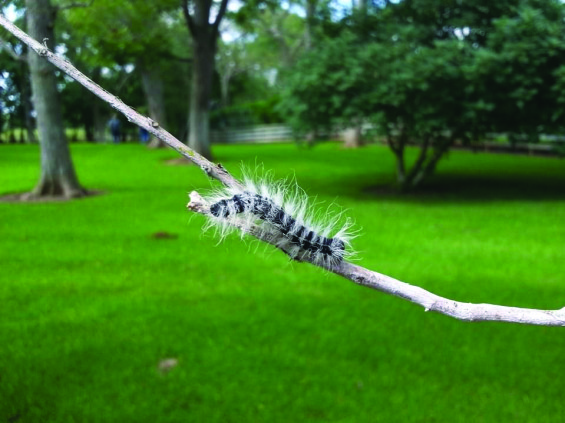Walnut Caterpillars Feasting on Pecan Foliage

Fort Bend County is experiencing a new generation of Walnut Caterpillar infestation.
AGRILIFE EXTENSION SERVICE OFFERS TIPS ON DEALING WITH THE PESTS
Site visits and numerous calls from around Fort Bend county have confirmed another generation of walnut caterpillars feeding on pecan foliage. The majority of cases range from Fulshear through Pecan Plantation, down to Richmond, and a few calls from south Rosenberg. Experts assume populations are active further out as well. The Walnut Caterpillar, Datana integerrima, is a foliage feeder of trees in the family Juglandaceae, which includes the pecans, hickories, and walnuts. Based on the caterpillar’s developmental time line and the period since the region’s last frost, this is almost certainly the third generation to hatch this season and the most widespread. One thing experts are noticing with this generation is a great range of growth stages, from first stage reddish-brown larvae all the way to the large 1½- to 2-inch black and white larvae, all in the same areas. This makes it even more of a challenge to treat effectively. Most trees in the county are carrying a good crop of nuts. Defoliation from walnut caterpillars will not kill healthy trees but will greatly affect harvest quality. Trees without leaves right now in mid-summer may experience a complete crop loss. If you plan to market your pecans, you should be very aware of any walnut caterpillar activity in your orchards and plan to respond accordingly to minimize any potential crop loss. Options: Professional Treatment Experts have found that many pest control companies and local certified arborists have been working in the affected areas. The cost of professional treatment can range from $50-$150 per mature tree. Though very effective, the cost adds up if you have to treat several times throughout the season. Also, with broad spectrum insecticides please be aware of potential secondary toxicity issues with pets, wildlife, and beneficial insects. Options: Spraying with Soapy Water or Insecticide A hose-end tree sprayer can be used to apply soapy water or an approved insecticide on clusters of molting caterpillars. Experts find that the last three larval stages will move down the tree to molt. Usually about half way down the tree, you may find large clusters of the caterpillars nesting while they are molting their exoskeleton. Once done molting, they will head back up in to the canopy to continue feeding. If you can scout the area each day and catch them while they come down to molt, you can use a hose-end tree sprayer to target soapy water or an approved insecticide right on the clusters. This method will not give you 100 percent control, but will greatly decrease populations, is easier on the local ecology, and is a whole lot cheaper. Bill Ree, Pecan Integrated Pest Management Specialist, says, “Without blindly spraying for them, we ask individuals to scout for new populations. If you see the new egg masses on mature foliage, it should be about a week before the larvae hatch out. The safest products for homeowner situations would be Bt (Dipel, Thuricide, Caterpillar Killer) and products with spinosad (such as Green Light Lawn and Garden with Spinosad), or the use of wetable Sevin (Carbaryl) plus soap.” If you cannot reach the top of the tree where the caterpillars are feeding, you may be able to catch them when they move down the tree and cluster to molt. This is usually about 6 to 15 feet up the tree and easy to spot with a little inspection. If you can catch them then, you can spray the cluster with dish soap and water (10 drops to 24 oz. water). Be aware of the potential for acute poisoning to pets and wildlife if you use some chemical pesticides on these insects. With the large populations of these, ingestion of treated insects by birds and other beneficial organisms may prove deadly. The extension agents note that caterpillars may be observed moving to other trees and shrub species, such as oaks and crapemyrtle, but they will not feed on them. They have simply used up their food stock and are desperately searching for more (pecan, hickory, or walnut) and may die on their own without enough energy to pupate into adult stage. For more information, contact Boone Holladay, Fort Bend County Extension Agent-Horticulture, or Bill Ree at the Fort Bend County Texas A&M AgriLife Extension Service in Rosenberg at 281-342-3034. Additional information and regular updates on pecan-related issues throughout the state may be found at the Texas Pecan Integrated Pest Management website, pecan.ipmPIPE.org Walnut Caterpillars Feasting on Pecan Foliage








